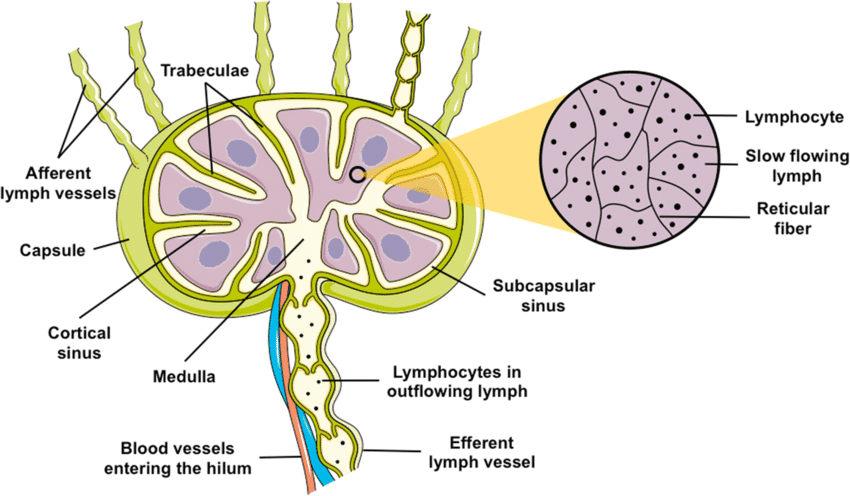What are Lymphatic System?
Lymph is a tissue fluid which is formed by the passage of substances from blood capillaries into tissue spaces. It flows in a closed system called lymphatic system. This system consists of lymph vessels, lymph capillaries, lymph nodes, etc.
Composition of Lymph
Lymph is a colourless fluid which consists of blood plasma and lymphocytes but not plateletes. It is alkaline in reaction. Compared to plasma it contain a high amount of fat.
Function of Lymphatic System
Here are the main functions of the lymphatic system:
- Fluid Balance: The lymphatic system helps maintain fluid balance in the body by collecting excess fluid, called lymph, that leaks out of blood vessels and tissues. This fluid is then transported back to the bloodstream, preventing the accumulation of excess fluid in tissues and preventing edema (swelling).
- Immune System Support: Lymph nodes, which are small, bean-shaped structures along the lymphatic vessels, play a crucial role in the immune system. They contain white blood cells, such as lymphocytes, which help filter and destroy pathogens (bacteria, viruses, and other harmful substances) present in the lymph. The lymphatic system also transports immune cells and antibodies throughout the body, contributing to the body’s defense against infections.
- Absorption of Fats: The lymphatic system is involved in the absorption of dietary fats and fat-soluble vitamins from the digestive system. Specialized lymphatic vessels called lacteals in the small intestine absorb these nutrients and transport them through the lymphatic system.
- Transport of Cells and Molecules: Apart from immune cells, the lymphatic system transports other cells, such as dendritic cells, which are important in presenting antigens to immune cells. It also transports hormones, nutrients, and waste products throughout the body.
- Filtration and Cleansing: Lymph nodes act as filters for the lymphatic fluid, removing foreign particles and debris. This helps purify the lymph before it is returned to the bloodstream.
- Drainage of Excess Tissue Fluid: The lymphatic system plays a crucial role in draining excess interstitial fluid (fluid between cells) from tissues. This process helps maintain the balance of fluids and prevents tissue swelling.
Lymph Nodes (Lymphatic glans)
Lymph nodes are small, bean-shaped structures found throughout the body as part of the lymphatic system. They play a crucial role in the immune system by filtering and monitoring lymph (a clear fluid that circulates through the lymphatic vessels).

Lymph nodes contain immune cells, including lymphocytes (such as B cells and T cells), macrophages, and dendritic cells, which work together to identify and combat foreign substances, such as pathogens and abnormal cells. Lymph nodes are small, round or bean-shaped structures, typically ranging in size from a few millimeters to about 2 centimeters in diameter. They are distributed along the lymphatic vessels throughout the body, with clusters found in areas like the neck, armpits, groin, and abdomen.
Function of Lymph Nodes
The primary functions of lymph nodes are closely tied to their role in the immune system. Lymph nodes serve as crucial filtering stations and hubs for immune cell interaction. Here are the key functions of lymph nodes:
- Filtration of Lymph: Lymph nodes act as filters for lymph, the clear fluid that circulates through the lymphatic vessels. Lymph contains a variety of substances, including pathogens (such as bacteria and viruses), cellular debris, and abnormal cells. As lymph passes through the lymph nodes, these structures trap and filter out foreign particles.
- Immune Surveillance: Lymph nodes are integral to the immune surveillance system. They contain a variety of immune cells, including B cells, T cells, macrophages, and dendritic cells. These cells work together to recognize and respond to antigens (foreign substances), initiating an immune response.
- Activation of Immune Responses: When immune cells within the lymph nodes encounter antigens, they become activated. This activation leads to the production of antibodies by B cells and the mobilization of T cells, both of which are essential components of the adaptive immune response. The immune response mounted in the lymph nodes is crucial for targeting and eliminating pathogens.
- Antigen Presentation: Dendritic cells within the lymph nodes play a key role in antigen presentation. They capture antigens in the periphery, such as in tissues, and then migrate to the lymph nodes. There, they present the antigens to T cells, initiating specific immune responses.
- Production of Antibodies: B cells in the lymph nodes play a central role in the production of antibodies. When activated by encountering specific antigens, B cells differentiate into plasma cells, which release antibodies into the bloodstream. Antibodies are essential for neutralizing and eliminating pathogens.
- Maturation of Immune Cells: Lymph nodes serve as sites for the maturation and education of certain immune cells, particularly T cells. T cells undergo a process of selection and maturation within the thymus and lymph nodes to ensure they can recognize and respond appropriately to antigens.
- Monitoring and Coordination: Lymph nodes are strategically located throughout the body, and they serve as monitoring stations for the immune system. They help coordinate immune responses by communicating with each other and with other immune organs.
- Response to Infections: When an infection occurs, lymph nodes near the site of infection may become swollen and tender. This enlargement is a result of increased activity and proliferation of immune cells within the nodes as they work to combat the infection.
Lymphatic Duct
The lymphatic ducts are major vessels of the lymphatic system responsible for transporting lymph, a clear fluid containing white blood cells, throughout the body. There are two primary lymphatic ducts: the thoracic duct and the right lymphatic duct. These ducts play a crucial role in maintaining fluid balance, immune system function, and the transport of various substances within the body.
- Thoracic Duct:
- The thoracic duct is the larger and main duct of the lymphatic system.
- It originates from the cisterna chyli, a dilated sac-like structure located at the level of the second lumbar vertebra.
- The thoracic duct ascends through the thoracic cavity and runs alongside the vertebral column, passing through the diaphragm and into the thoracic region.
- Right Lymphatic Duct:
- The right lymphatic duct is smaller and drains lymph from the upper right quadrant of the body.
- It receives lymphatic drainage from the right side of the head and neck, the right arm, and the right upper thoracic region.
- The right lymphatic duct typically empties into the junction of the right subclavian vein and the right internal jugular vein.
Functions of the Lymphatic Ducts:
- Transport of Lymph: The primary function of the lymphatic ducts is to transport lymph throughout the body. Lymph is collected from interstitial fluid in tissues and drains into lymphatic vessels, eventually forming larger lymphatic ducts.
- Fluid Balance: The lymphatic system, including its ducts, plays a crucial role in maintaining fluid balance by collecting excess interstitial fluid and returning it to the bloodstream. This helps prevent edema or swelling of tissues.
- Immune System Support: Lymph, as it circulates through the lymphatic system, passes through lymph nodes. Lymph nodes are key components of the immune system, and they help filter and remove pathogens from the lymph. This process contributes to the body’s defense against infections.
- Transport of Nutrients and Waste Products: Apart from immune cells, lymph also carries nutrients, hormones, and waste products. The lymphatic system, including its ducts, facilitates the transport of these substances between tissues and the bloodstream.
- Absorption of Dietary Fats: Lymphatic vessels called lacteals in the small intestine absorb dietary fats and fat-soluble vitamins. The absorbed fats are transported through the lymphatic system, eventually reaching the bloodstream.
Spleen
The spleen is a large organ located in the upper left side of the abdomen, beneath the ribcage. It is highly vascular and bean shaped and measures about 12cm in length. It is a part of the lymphatic system and is involved in various important functions, including immune response, blood filtration, and storage of platelets.
Function of Spleen
The spleen is a crucial organ with various functions in the human body. Here are the primary functions of the spleen:
- Blood Filtration:
- The spleen acts as a blood filter, removing old, damaged, or abnormal red blood cells (erythrocytes) from the bloodstream. It helps maintain the quality of blood by eliminating cells that are no longer functional.
- Immune Response:
- The spleen plays a key role in the immune system. It contains white blood cells, including lymphocytes, which are important for recognizing and responding to foreign substances (antigens) such as bacteria and viruses.
- The spleen helps initiate immune responses by filtering blood and trapping pathogens. It is involved in the production of antibodies and the activation of immune cells, contributing to the body’s defense against infections.
- Storage of Platelets:
- The spleen acts as a reservoir for platelets, which are small cell fragments involved in blood clotting. During times of need, such as in response to bleeding or injury, the spleen releases stored platelets into the bloodstream.
- Hematopoiesis (Fetal Development):
- In fetal development, the spleen is involved in the production of red blood cells. However, this function decreases as the bone marrow takes over the role of red blood cell production after birth.
- Red Blood Cell Recycling:
- The spleen participates in the recycling of components from broken down red blood cells. It breaks down hemoglobin from old red blood cells, releasing iron and bilirubin. Iron is then reused for the production of new red blood cells, while bilirubin is processed by the liver.
- Storage of Blood:
- The spleen can store a small amount of blood, acting as a reservoir that can be released into circulation when needed, such as during times of increased demand.
It’s important to note that while the spleen performs these crucial functions, it is not considered an essential organ for survival. However, individuals without a spleen or with a non-functioning spleen may have an increased susceptibility to certain infections, and they may need to take precautions, such as vaccinations, to protect against specific pathogens.
Reference
Dr. N.MURUGESH, Basic Anatomy and physiology 2018, Sixth Edition, Page No. 80-85
